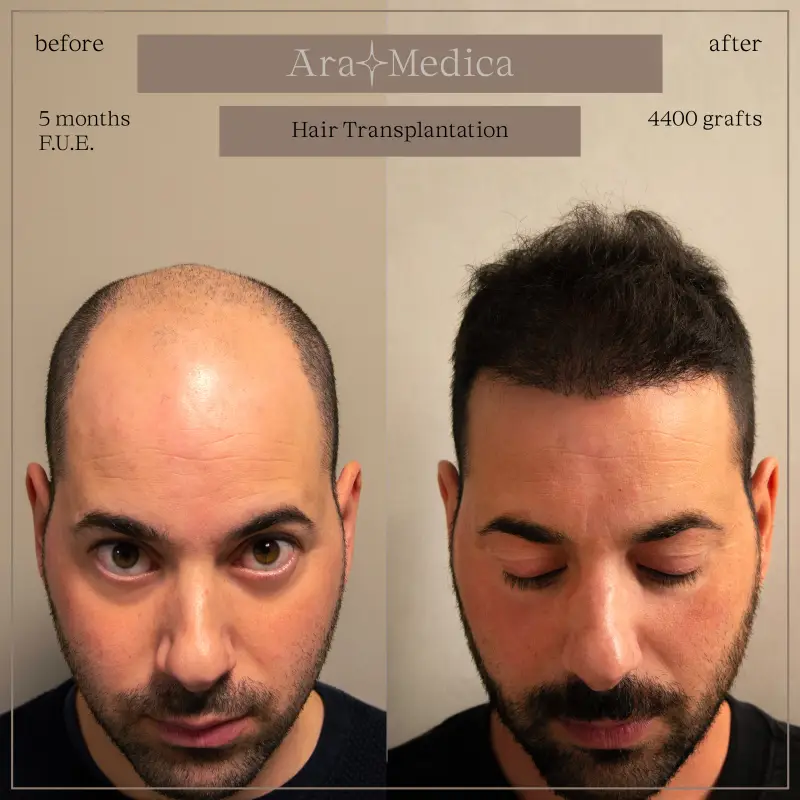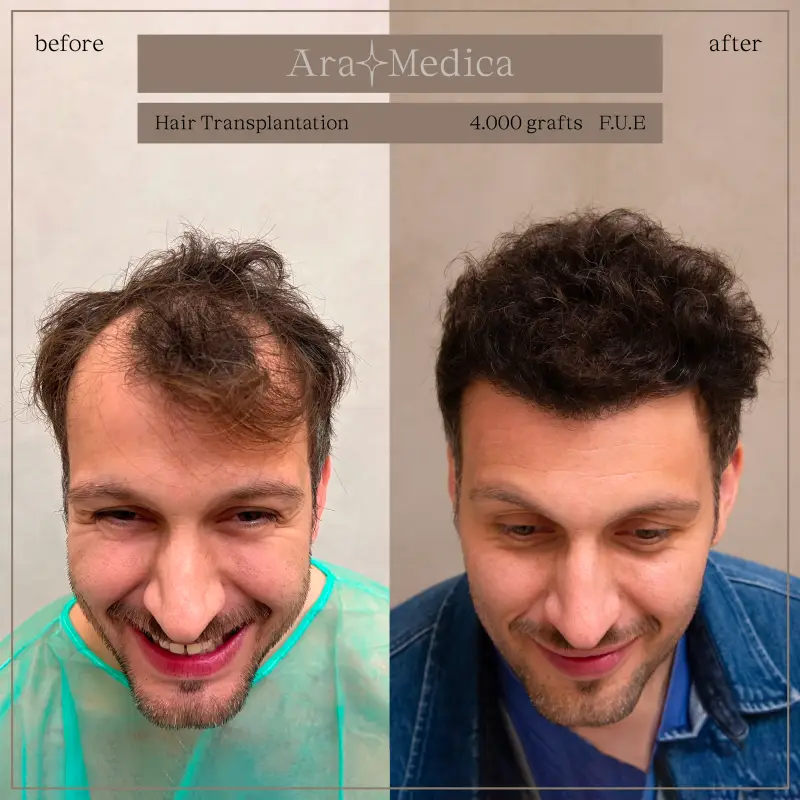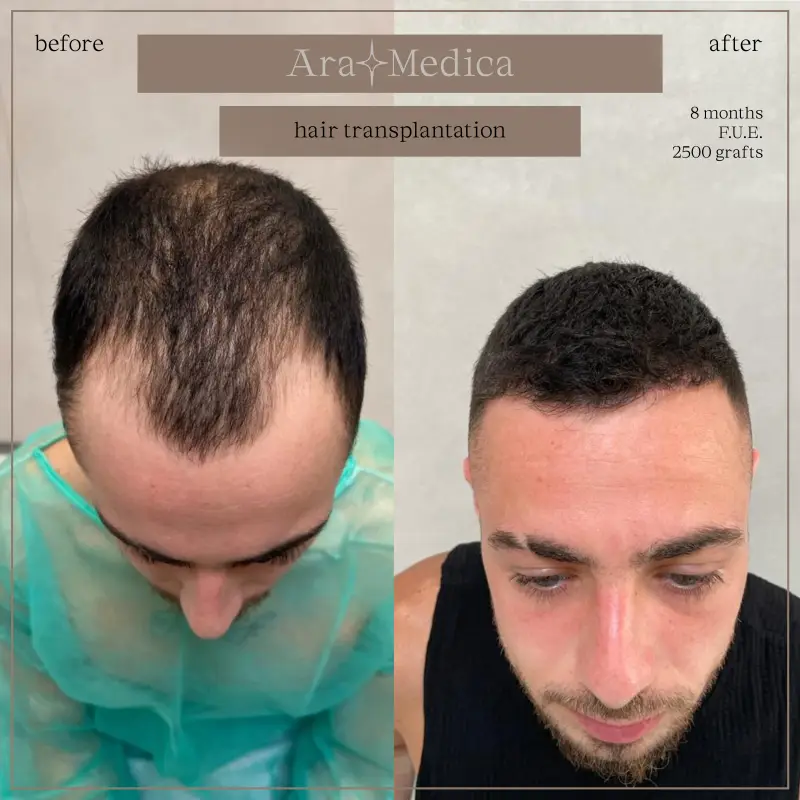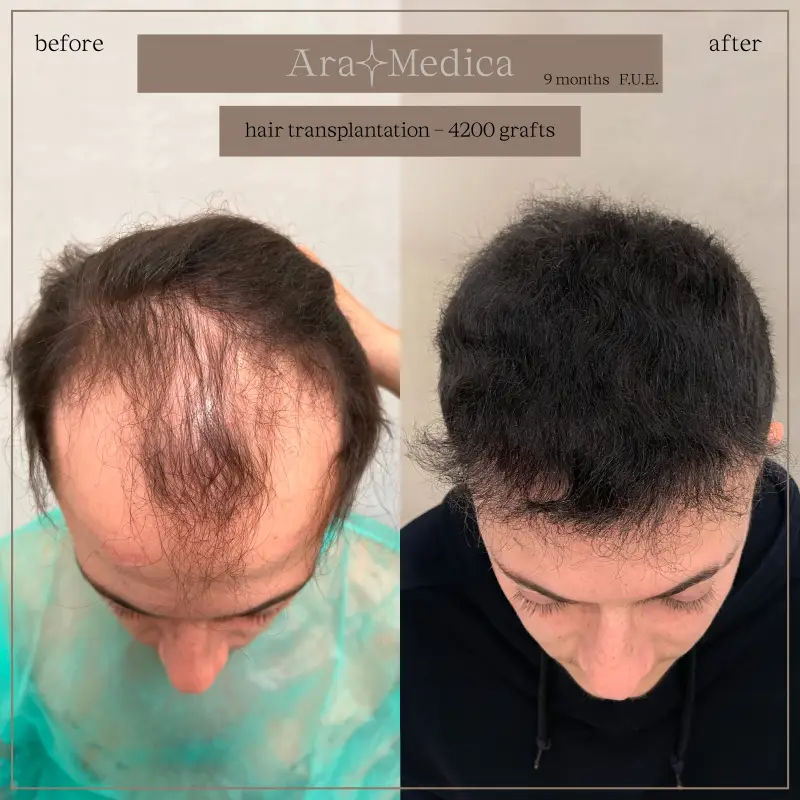Hair transplant overview
Hair Transplant Overview
- Call with Our Agent
- Online Consultation with a Doctor
- Flight to Italy
- In Person Appointment with a Doctor
- Blood Tests and Exams
- Hair Line Consultation
- Local Anesthesia
- Hair Transplantation
- Medication
- LED Light Therapy
- Flight back to US
Hair is crucial in shaping appearance and self-esteem. That’s why many invest in hair grooming to boost their look and confidence. Here’s the impact that a hair transplant at AraMedica Clinic can have. Hair thinning, loss, and baldness often stem from aging, stress, health problems, and genetics. In an ideal world, there would be no bias, but societal stereotypes frequently associate baldness with aging and reduced attractiveness. This can undermine confidence and hinder individuals from interacting confidently with others. That was also a case of our beloved client Jindra. See this video where he talks more about his journey.
Experiencing hair loss can be distressing, whether you’re a man or a woman. For many, the prospect of thinning hair or baldness is a significant concern.
You don’t need to accept hair loss or wait until it’s too late. Seeking an immediate hair restoration consultation at AraMedica is key for optimal results and to assess if a hair transplant is right for you.
Since the 1950s, hair transplants have been effectively treating baldness and thinning areas. This method has proven successful for both men and women, preventing hair loss and promoting a fuller appearance.
At AraMedica, we take a “boutique” style approach, different from many modern clinics, to ensure comfort, effectiveness and individual approach.
Our main aim is to use the most appropriate technique for a successful outcome that suits your needs. Our clients often share how the surgery boosted their self-esteem and provided a natural-looking, confidence-enhancing head of hair.
Before & After Gallery
Disclaimer: Outcome or results shown are not guaranteed and may vary from patient to patient. Cosmetic procedures are associated with possible risks and complications, always have a thorough discussion with your surgeon. Images posted with consent.
We Also Specialize in Female Hair Transplant Procedures
Hair loss in women is often a deeply personal and emotional experience, and we understand the unique challenges it presents. While our clinic is renowned for male hair restoration, we are equally committed to providing top-tier solutions for women.
Our female hair transplant procedures are designed to address thinning hair, receding hairlines, or areas of hair loss due to conditions like androgenetic alopecia, hormonal changes, or medical treatments. Using advanced techniques such as Follicular Unit Extraction (FUE), we carefully and precisely transplant healthy hair follicles to achieve natural, undetectable results.
Female hair restoration requires a customized approach, as hair loss patterns in women differ significantly from men. Our team works closely with each patient to create a personalized treatment plan that complements their unique needs and aesthetic goals.
Whether you're looking to restore density to thinning areas, rebuild your hairline, or achieve a fuller, more youthful appearance, our expertise in female hair transplantation ensures exceptional results.
Discover how we can help you regain your confidence. Schedule a consultation today!
What Is a Hair Transplant Procedure?
At Ara Medica, a hair transplant procedure involves relocating hair follicles from a donor area, typically the back or sides of the scalp, to areas experiencing hair loss. This process helps restore thinning or balding areas with natural-looking results. The primary technique is Follicular Unit Extraction (FUE) which is minimally invasive. Over time, the transplanted hair grows naturally, leading to fuller, thicker hair and improved confidence.
Who Is a Candidate for a Hair Transplant Procedure?
Ideal candidates for a hair transplant procedure are individuals experiencing significant hair thinning or balding, often due to male or female pattern baldness. Candidates should have sufficient healthy hair in the donor area, typically the back or sides of the scalp, to provide the follicles needed for transplantation. Additionally, good overall health is crucial to ensure a smooth recovery. While age isn’t a strict factor, those with stable hair loss patterns tend to see the best, long-lasting results from the procedure.
What is FUE?
FUE, or follicular unit extraction, is a method of extracting hair strands from the back of the scalp without leaving a noticeable linear scar. Instead, small micrografts are individually removed using a 1-millimeter punch tool, creating almost imperceptible pinpoint scars. The benefit of this technique is that the hair in the donor area can be cut short without exposing the micrografts. Although the graft harvesting process is time-intensive, its advantages are significant for patients. FUE is particularly recommended for younger people, African-Americans, those with limited donor hair, and transman patients seeking to grow facial hair such as beards, mustaches, sideburns, and fuller eyebrows. Need more information about either of these techniques?
Life is not perfect
But your hair can be
Online assessment
Hair Transplant Lecce, Puglia Procedure Overview
Your journey to a hair transplant begins with the decision to undergo the procedure in Lecce, Puglia. The first step is choosing the right medical facility, ensuring it’s performed by a professional surgeon or hair restoration technician tailored to your hair condition and needs. At Ara Medica, our fully accredited operating room upholds the highest standards of safety, sterility, and comfort. Our skilled medical team ensures you’re in good hands. An initial consultation is key, where our doctors will discuss your unique concerns, review any previous hair transplants, assess your hair care products, and examine your medical history and medications. A physical examination follows to understand your hair loss pattern. Your hair’s texture, thickness, and color are evaluated to determine suitability for surgery. If eligible, your hair transplant Lecce, Puglia will be scheduled. The operation typically starts early in the morning. You’ll change into a comfortable gown, slippers, and robe in preparation. A final consultation outlines the procedure, discussing goals and objectives. The hairline design is then established, focusing on natural appearance and symmetry, and pre-surgery hair photos are taken for reference.
For the follicular unit extraction (FUE) process, hair at the back is trimmed short. In the strip technique, only the strip area is trimmed. You’re then taken to the procedure room for local anesthesia. During follicular unit grafting (FUG), each follicle is harvested individually under high magnification. In the strip method, the surgeon removes the strip and sutures the site skillfully. Positioned face-down, you can listen to music or podcasts, or even nap, while the team works. Post-harvesting, each graft is examined under a microscope. The transplant phase uses the “stick and plant” method for precise, natural-looking results. Seated comfortably during graft implantation, you can watch TV or relax. After the procedure, you’ll appreciate its ease and painlessness. We invite you to explore our patient testimonials and reviews for more insights.
Hair Transplant Recovery & Hair Growth
Following the procedure, patients in Lecce, Puglia will leave with minimal bandaging or a head cover to protect the transplant area. Right after the transplant, a fuller head of hair is immediately noticeable. To reduce swelling, antibiotics and medications are prescribed for the first three days. Mild pain relief is recommended for the initial two nights to aid in comfortable sleep. With limited downtime, most patients can quickly return to work and regular activities. Post-surgery hair washing is possible but requires gentle care. Activities like swimming, intense exercise, and weightlifting should be postponed for about one to two weeks. Transplanted hair growth typically becomes visible within four to six months. Many use Minoxidil, a topical solution, to encourage faster hair growth. Applied nightly, it can hasten the growth of transplanted hair, though some may experience immediate post-transplant growth. The full results of the hair transplant in Lecce, Puglia usually manifest within 12 to 18 months. Continuous hair growth after this period provides a fuller head of hair for years to come.
How to Care for Your Hair Years After a Hair Transplant Procedure
To care for your hair years after a hair transplant, maintain a gentle hair care routine using sulfate-free shampoos. Avoid harsh chemical treatments, protect your scalp from excessive sun exposure, and consider ongoing treatments to stimulate growth. Regular check-ups with our hair transplant specialist can also help monitor the health of your hair and scalp. Finally, a balanced diet rich in vitamins and minerals, along with a healthy lifestyle, supports long-term hair health and enhances the results of your transplant.
Ara Medica's dream team
Dr. Luca Fossati
General Medicine and Trilocogy Specialist
General Medicine, expert in nutrition and trichology.
Dr. Cristina Vito
General Medicine and Trichology Specialist
Plastic Surgeon, specializing in general surgery, oncological surgery, plastic aesthetic, and reconstructive surgery.
Dr. Luis Eduardo Gesù
Plastic Surgeon
Sergio Zorbo
Anesteziolog
Andrologist, specialized in andrology, urology, and sexology.
Dr. Michele Cotugno
Andrologist
Plastic Surgeon, specializing in plastic, reconstructive, and aesthetic surgery, with a master's degree in complex wounds.
Dr. Vito Cazzato
Plastic Surgeon
Hair Transplant FAQs
Hair loss and balding primarily stem from genetics, often manifesting as a hereditary condition in both sexes as early as their twenties. Other factors contributing to hair loss include autoimmune diseases like alopecia areata or lupus, significant life events such as surgeries, childbirth, and major weight loss, as well as certain medications. Skin disorders like psoriasis or seborrheic dermatitis, and nutritional deficiencies, particularly in iron, are also linked to hair loss. Additionally, hair styling practices involving excessive heat or frequent coloring can exacerbate hair thinning.
Hair transplants use main technique: follicular unit extraction (FUE). FUE differs by individually harvesting each follicular unit with a precise circular device, leaving tiny, virtually undetectable scars. These follicles are then implanted in areas needing hair.
Smaller sessions may take two to four hours. Larger sessions can last five to seven hours.
Recovery after a hair transplant is usually straightforward and less painful than expected. Post-surgery, any redness or discomfort at the transplant site typically fades within a few days. Infection risks are minimal, with few complications reported. After the surgery, showering is painless, but avoid shampooing or vigorous scrubbing for a few days. You can gently wash your hair after four days and resume normal washing after a week. Most return to work or activities within one to two days post-surgery. However, heavy lifting and intense exercise should be avoided for about a week for a smooth recovery.
Hair transplants, when performed using advanced techniques by experienced, board-certified surgeons and technicians, generally have a high success rate. Modern procedures can achieve up to a 95% success rate. This reflects the effectiveness of the procedures and the natural-looking quality of the results. Patients can expect significant hair restoration that blends well with their natural hair growth patterns.
Hair growth post-transplant is a gradual process, and the timeline varies per individual. Typically, new hair growth starts within four to eight months after the procedure. However, it may take 12 to 18 months for the full effects to become noticeable. This period allows the hair to grow, thicken, and match the existing hair’s texture.
The number of required hair transplant sessions varies, depending on the extent of hair loss and desired density. Some patients may reach their goals in one session, while others might need two or three for optimal coverage. The initial plan is based on an assessment of hair loss patterns and donor hair health. Ongoing hair loss might necessitate additional sessions in the future to maintain appearance.
Yes, transplanted hair is generally permanent. The follicles moved from the donor area to balding areas are typically resistant to balding. Thus, these hairs will continue growing in their new location for a lifetime, making transplantation a long-term solution for hair loss. However, while the transplanted hair remains, hair loss in non-treated areas may continue, possibly affecting overall appearance and requiring further treatmen
Unfortunately, transplanting someone else’s hair is not possible due to the risk of immune rejection, similar to organ transplant incompatibility. Successful hair transplants require using your own hair, typically from areas resistant to hair loss, like the back or sides of the head.
The survival rate of transplanted hairs is generally high, often reported as 95% or more, when the procedure is performed correctly. Following post-operative care instructions and the surgeon’s guidance is key to ensuring the best outcome.
Yes, implanted hair can look very natural. Advanced techniques, like FUE, have made unnatural “pluggy” appearances a thing of the past. Each graft is carefully placed to follow your natural hair growth pattern, ensuring a seamless blend with your existing hair.
In most cases, there are no visible scars in the transplanted area. However, fine lines may be present in the donor area, typically hidden within the hair and not noticeable with normal hair lengths. For those preferring short hairstyles and concerned about scarring, Follicular Unit Extraction (FUE) is recommended for its less noticeable scarring compared to the traditional Follicular Unit Transplantation (FUT) or strip method.
The recovery time after a Lecce, Pugliahair transplant is relatively short. Most individuals can resume their normal, non-strenuous activities within 24 hours post-surgery. However, it’s advised to avoid intense physical activities for about one to two weeks to ensure proper healing.
Many people consider a hair transplant a valuable investment, particularly after long-term struggles with hair loss. A successful transplant can greatly enhance appearance and self-confidence. Deciding on a hair transplant should involve careful consideration and consultation with a qualified hair restoration specialist.
Hair transplant surgery typically isn’t painful. Local anesthesia is administered for comfort, and mild oral sedatives may be provided to ease any discomfort. The overall pain level can also depend on the clinic’s environment and the care of the staff, contributing to a more comfortable experience during consultation, procedure, and post-operative care.
It’s recommended to arrange transportation home after the procedure, like a family member or friend driving you. Oral sedation used during the procedure can cause drowsiness, making it unsafe for you to drive.
You should wait at least 48 hours before washing your hair post-transplant. When you start washing your hair, follow your surgeon’s instructions carefully. They may advise using a gentle shampoo and avoiding direct water pressure or vigorous scrubbing to protect the grafts.
After hair transplant surgery, temporary scabbing in the treated areas might be noticeable for about 5 to 7 days. If you have longer hair, it can help conceal signs of the surgery. For shorter hair, or if you’re concerned about visibility, wearing hats or other head coverings is an effective way to disguise these signs until the scabs heal and become less noticeable
It’s best to avoid prolonged and direct sun exposure for about three months post-transplant. Direct sunlight can harm the sensitive transplanted follicles and may cause scalp irritation. When outdoors, it’s advisable to use protection like hats or umbrellas.



